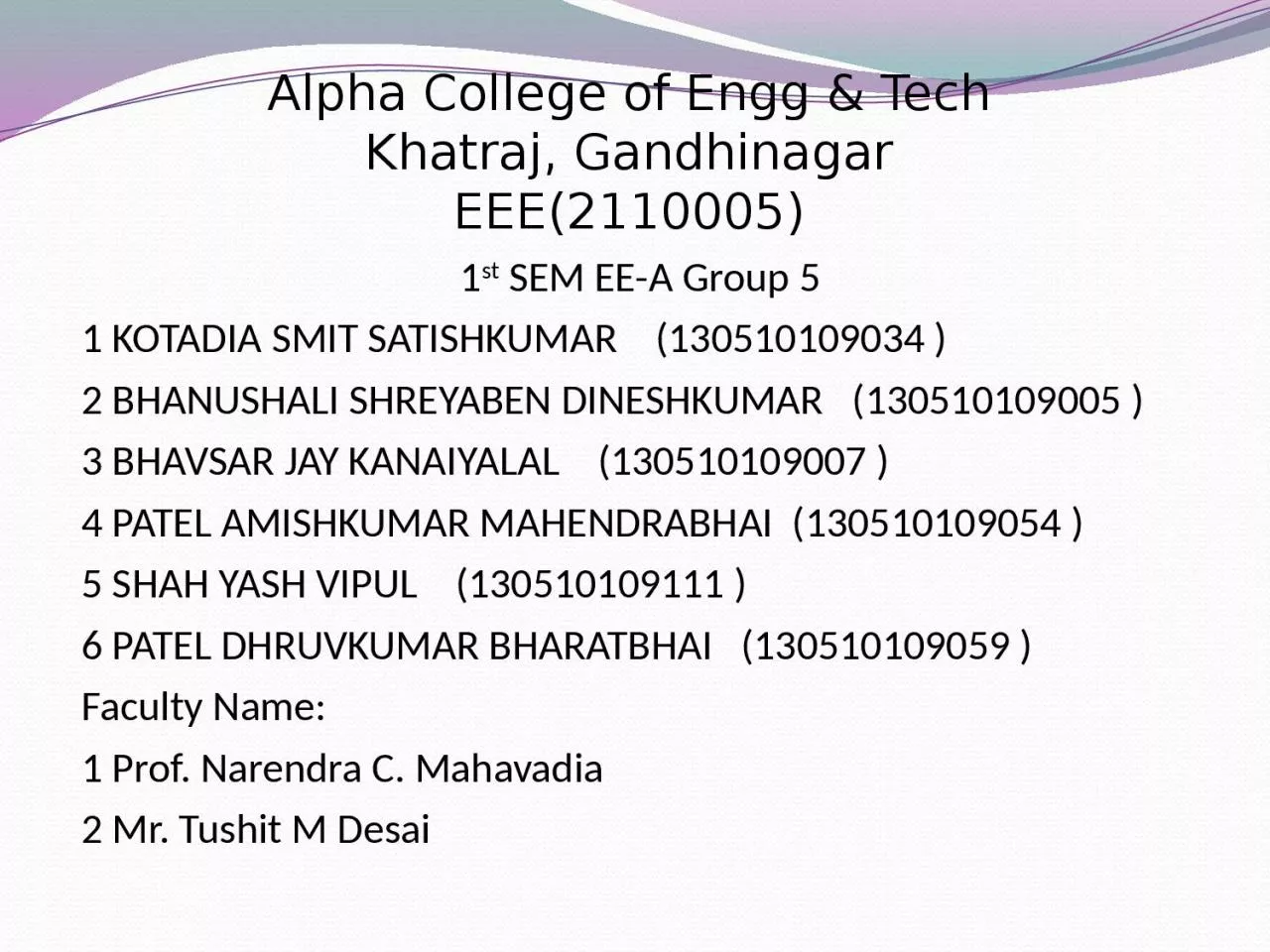

Khatraj Gandhinagar EEE2110005 1 st SEM EEA Group 5 1 KOTADIA SMIT SATISHKUMAR 130510109034 2 BHANUSHALI SHREYABEN DINESHKUMAR 130510109005 3 BHAVSAR JAY KANAIYALAL 130510109007 ID: 1030572
Download Presentation The PPT/PDF document "Alpha College of Engg & Tech" is the property of its rightful owner. Permission is granted to download and print the materials on this web site for personal, non-commercial use only, and to display it on your personal computer provided you do not modify the materials and that you retain all copyright notices contained in the materials. By downloading content from our website, you accept the terms of this agreement.
1. Alpha College of Engg & TechKhatraj, GandhinagarEEE(2110005)1st SEM EE-A Group 51 KOTADIA SMIT SATISHKUMAR (130510109034 )2 BHANUSHALI SHREYABEN DINESHKUMAR (130510109005 )3 BHAVSAR JAY KANAIYALAL (130510109007 )4 PATEL AMISHKUMAR MAHENDRABHAI (130510109054 )5 SHAH YASH VIPUL (130510109111 )6 PATEL DHRUVKUMAR BHARATBHAI (130510109059 )Faculty Name:1 Prof. Narendra C. Mahavadia2 Mr. Tushit M Desai
2. TopicPower Triangle Active , Reactive & Apparent power Method of Power Factor Improvement
3. Power TriangleWhen each component in fig. is multiplied by a voltage V, a Power Triangle is obtained as shown in fig.
4. Power diagram for capacitive loads.Power diagram for inductive loads.
5. True, reactive, and apparent powerIn a simple alternating current (AC) circuit consisting of a source and a linear load, both the current and voltage are sinusoidal. If the load is purelyresistive, the two quantities reverse their polarity at the same time. At every instant the product of voltage and current is positive, indicating that thedirection of energy flow does not reverse. In this case, only real power is transferred.
6. If the loads are purely reactive, then the voltage and current are 90 degrees out of phase. For half of each cycle, the product of voltage and current ispositive, but on the other half of the cycle, the product is negative, indicating that on average, exactly as much energy flows toward the load as flowsback. There is no net energy flow over one cycle. In this case, only reactive energy flows—there is no net transfer of energy to the load.Practical loads have resistance, inductance, and capacitance, so both real and reactive power will flow to real loads. Power engineers measure apparentpower as the magnitude of the vector sum of real and reactive power. Apparent power is the product of the root-mean-square of voltage and current.
7. Conventionally, capacitors are considered to generate reactive power and inductors to consume it. If a capacitor and an inductor are placed in parallel,then the currents flowing through the inductor and the capacitor tend to cancel rather than add. This is the fundamental mechanism for controlling thepower factor in electric power transmission; capacitors (or inductors) are inserted in a circuit to partially cancel reactive power 'consumed' by the load.
8. SQPTrue power, P, or active power: watt (W)Reactive power, Q: volt-ampere reactive (var)Apparent power, |S|: the magnitude of complex power S: volt-ampere (VA)Phase of voltage relative to current, φ: the angle of difference (in degrees) between voltage and current; current lagging voltage (quadrant I vector), current leading voltage (quadrant IV vector)
9. Active PowerInstantaneous power to a load is p = v • iIn an ac circuitp may be positive sometimes and negative other timesAverage value of the power, PReal powerAverage value of instantaneous power, real power, active power, and average power mean the same thing
10. Reactive PowerDuring times when p is negative, power is being returned from loadThis can happen for inductive or capacitive loadsPower that flows into these loads and back out is called the reactive powerAverage value of reactive power is zero
11. Active and Reactive Power EquationsP = VI cos = S cos Q = VI sin = S sin V and I are RMS values is the phase angle between V and IQ is positive for inductive circuits and negative for capacitive circuits
12. Apparent PowerPower to a load is VIIf load has both resistance and reactanceProduct is neither the real power nor the reactive power, but a combination of bothThis is called the apparent power, SS = VI = I2Z = V2/ZUnits are volt-amperes (VA) Defining the apparent power to a load.
13. Power Factor Improvement
14.
15.
16. Ratio of real power to apparent power is called the power factor, FpIt's a practical measure of the efficiency of a power distributionsystem. For two systems transmitting the same amount of real power, the system with the lower power factor will have higher circulating currents due toenergy that returns to the source from energy storage in the load. These higher currents produce higher losses and reduce overall transmission efficiency.A lower power factor circuit will have a higher apparent power and higher losses for the same amount of real power.
17. energy that returns to the source from energy storage in the load. These higher currents produce higher losses and reduce overall transmission efficiency.A lower power factor circuit will have a higher apparent power and higher losses for the same amount of real power.
18. Fp = P/S = cos Angle is angle between voltage and currentFor pure resistance = 0°For inductance, = 90°For capacitance, = -90°For a circuit containing a mixture, is somewhere between 0° and 90°Demonstrating the impact of a capacitive element on the power factor of a network.
19. Unity power factorFor a purely resistive circuit, the power factor will be oneFor load containing resistance and inductancePower factor will be less than one and laggingCurrent lags the voltageThe power factor is unity (one) when the voltage and current are in phase. It is zero when the current leads or lags the voltage by 90 degrees. Powerfactors are usually stated as "leading" or "lagging" to show the sign of the phase angle of current with respect to voltage.
20.
21. THANK YOU.